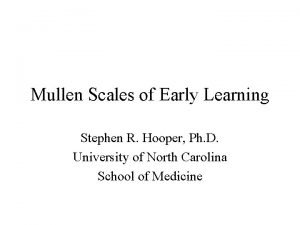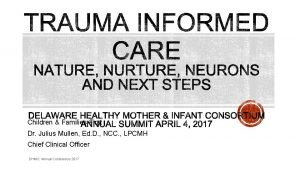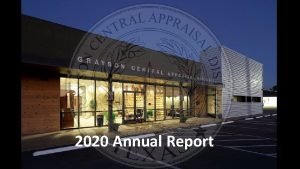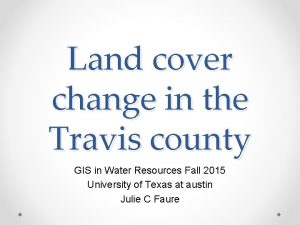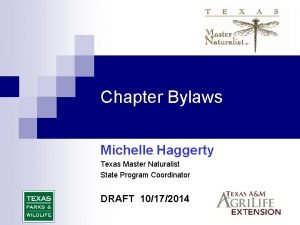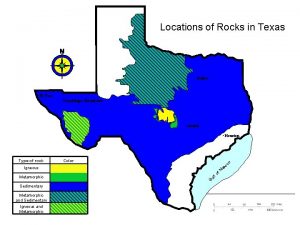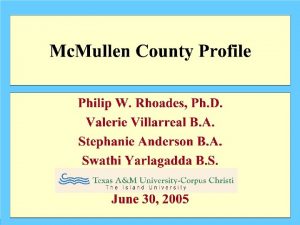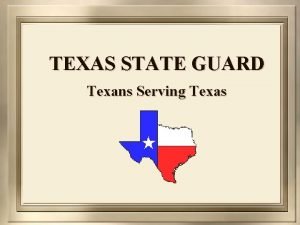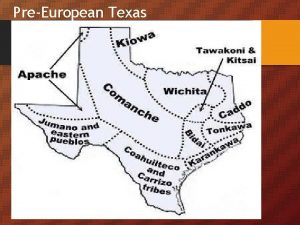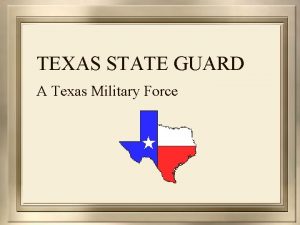Mc Mullen County Texas mcmullencounty org Mc Mullen












- Slides: 12

Mc. Mullen County Texas mcmullencounty. org Mc. Mullen County Local Emergency Planning Committee Phone: 361 -274 -3900 Fax: 361 -274 -3693 Chairman: Judge James Teal Vice Chairman: Joe Vasquez Address: Mc. Mullen County LEPC, C/O Judge James Teal 501 River Street, Tilden, Texas 78072 Secretary: Michelle Joseph Welcome to the Mc. Mullen County Local Emergency Planning Committee webpage The Local Emergency Planning Committee serves as the focal point for emergency response planning for emergencies involving natural disasters, hazardous materials and for the management of information within the County. The Committee is also responsible for the development and distribution of a local emergency response plan. (Emergency Planning and Community Right to Know Act of Title III of the Superfund Amendments and Reauthorization Act of 1986)

The LEPC is a product of federal legislation that was passed in the wake of the Bhopal disaster in India, where thousands of people died because of an accident involving hazardous materials. To prevent similar occurrence in our communities, in 1986 Congress passed a law that establishes requiremen for businesses and for federal, state and local governments regarding emergency planning and community righ to know. LEPC's are links between citizens, industry and the government. Because LEPC's are most familiar with the hazards in their own community, and because local citizens tend to be the first responders in an emergency, LEPC's are in the best position to assist local governments in developing emergency plans. The role of an LEPC is to form a partnership with local governments and industries as a resource for enhancing hazardous materials preparedness. Membership comes from the local area, representing various organizations, agencies, departments, facilities and other groups within the county.

Additional Pages What is the LEPC? LEPC Duties How are theses laws enforced? LEPC Bylaws Tier Two Reporting Membership Opportunities LEPC Mission Statement

How are theses laws enforced? Understanding SARA Title III CONTENT CONTROL START What is SARA Title III? The Comprehensive Environmental Response, Compensation and Liability Act (CERCLA), the original Superfund act, was passed by Congress in 1980 to clean up the nation's hazardous waste sites. In response to continuing community concern about hazardous materials and chemical release tragedies such as the incident in Bohpal, India, a reauthorization and expansion of Superfund was signed into law October 17, 1986. It is known as the Superfund Amendments and Reauthorization Act (SARA). Title III of SARA created a new nationwide program known as the Emergency Planning and Community Right-to-Know Act (EPCRA). What is the purpose of SARA Title III? The law was designed to improve local hazardous materials emergency response capabilities and provide the public with information about hazardous and toxic chemicals in their community. SARA Title III: Requires communities to develop emergency plans to protect themselves from chemical accidents. Gives citizens the right to know about hazardous chemicals stored and released in their community.

How are theses laws enforced? SARA Title III is divided into the following sections: Emergency Planning and Facility Notification (Sections 301 -303). Emergency Notification (Section 304). Community Right-to-Know Reporting Requirements (Sections 311 -312). Sections 311 -312 apply to businesses but exempts substances and fertilizers used in routine agricultural operations. Toxic Release Inventory Reporting (Section 313). Section 313 applies only to manufacturers. What are the state and community responsibilities under SARA Title III? The governor appoints a State Emergency Response Commission (SERC). The SERC then appoints and coordinates Local Emergency Planning Committees (LEPCs). LEPCs are established in every county. The LEPC is made up of volunteers from your community who are working to protect the health and welfare of the local public. The committee is responsible for developing a comprehensive hazardous materials emergency response plan for all facilities and farms that need one. The plan should identify the facility, emergency response and notification procedures, training programs and evacuation plans.

LEPC Duties LEPCs Are Required to Do Appoint a chairperson, and establish rules by which the committee shall function. • Rules shall include provisions for public notification of committee activities, public meetings to discuss the emergency plan, public comments, response to such comments by the committee, and distribution of the plan. • Establish procedures for receiving and processing requests from the public for information under Section 324, including Tier II information under Section 312. Such procedures shall include the designation of an official to serve as coordinator for information. • Complete preparation of an emergency plan and review the plan at least once a year. • Evaluate the need for resources necessary to develop, implement, and exercise the emergency plan, and shall make recommendations with respect to additional resources that may be required, as well as the means for providing such additional resources. • Submit a copy of the emergency plan to the State Emergency Response Commission (SERC). • Upon request by any person, make available a Safety Data Sheet (SDS) to that person in accordance with Section 324.

LEPCs Are Required to Do • Respond to a request for Tier II information under this paragraph no later than 45 days after the date of receipt of the request. • Make available to the general public each emergency response plan, Safety Data Sheet (SDS), chemical list described in Section 31 1(a)(2), inventory form, toxic chemical release form, and follow-up emergency notice. • Annually publish a notice on webpage that the emergency response plan, Safety Data Sheets (SDS), and inventory forms have been submitted. • May commence a civil action against an owner or operator of a subject facility for failure to provide information under Section 303(d) or failure to submit Tier II information under Section 312(e)(l). (Section 326(a)(2)(B). • Notify the State Emergency Response Commission of nominations for changes in the makeup of the LEPC. Nominations must be submitted in written form to the county judge; and, shall notify the SERC of address changes for the LEPC chairperson. Reference is Public Law 99 -499, passed by the 99 th Congress, October 17, 1986, and is intended to be used as a guideline by Local Emergency Planning Committees. The complete Act should be used by the LEPC when making decisions regarding actions of the LEPC. The Federal Register and other appropriate documents should be referenced by the LEPC to stay up-to-date on changes since the enactment of the law and on future changes to the law.

Tier II Reporting IMPORTANT NOTICE: All Tier II Reports are due to the State, local LEPC and Fire Department by March 1 of each year Mc. Mullen County’s LEPC receives reports in PDF format by March 1, to Judge. Teal@mcmullencounty. org The LEPC also accepts hard copies sent to the mailing address. TIER 2 Submit The Mc. Mullen County LEPC encourages stakeholders to submit their Tier II Reports electronically in a format compatible with TIER 2 SUBMIT (see https: //www. tceq. texas. gov/permitting/tier 2/tier-2 -chemical-reporting). The EPA, LEPC, and Mc. Mullen County Emergency Responders are working together to enhance first response in Mc. Mullen County and the neighboring counties in the region.

Tier II Reporting What Chemicals Must be Reported Hazardous Materials subject to regulation include: • • • Extremely Hazardous Substances Hazardous Chemicals over 10, 000 lbs. Toxic Chemicals EPA Response Management Plan List of Toxics & Flammables It is the responsibility of the business/industry to determine what chemicals and corresponding Threshold Planning Quantities (TPQ) are to be reported. Please refer to Safety Data Sheet (SDS) accompanying materials.

Tier II Reporting Failure to report can result in a Federal, state and local civil violation if: • An incident occurs and no Tier II Report is on file with either of the above; • A spill or release of a reportable nature is not reported within the specified time-frame as required by law, whether or not first responders were dispatched. Additionally, responding agencies are entitled by law to recover the costs of securing, containing, and managing an incident. Important Dates to Remember ALL Tier II Reports and copies are due to your local Fire Department and the Mc. Mullen County LEPC by March 1 of each year, for the previous year January 1 through December 31 (for example, filing deadline March 1, 2016 for January 1 through December 31, 2016). In the State of Texas Tier II Reports may be submitted any time between January 1 and March 1; avoid the rush and file early. Since September 2006, all Tier II Reports required by the Texas Department of State Health Services must be prepared electronically; via https: //www. tceq. texas. gov/permitting/tier 2/

Membership Opportunities An Active Member is one who has attended at least two meetings in the last 12 months. Those new to the LEPC will be considered a member upon attendance of their second meeting within the 12 month period. All members of the LEPC shall serve at the pleasure of the Mc. Mullen County. Voting Rights Each standing member of the committee shall have one vote.

Mc. Mullen County LEPC Mission Statement Mc. Mullen County LEPC Mission is to enhance citizen’s safety and reduce risk through continuous improvement of emergency planning, preparedness, mitigation and public awareness in partnership with county residents, businesses, emergency responders and industry. Together with our partners we will exchange information and conduct pre-incident planning and as a result work effectively together in the event of a disaster or hazardous emergency.
